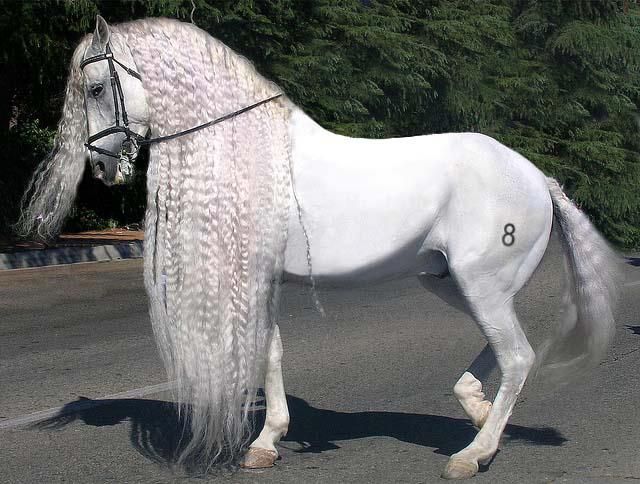Andalucian Horses
ANDALUSIAN
Hailing from the Iberian Peninsula, the Andalusian takes its name from the Province of Andalucia, where it was most famous. This living antiquity is purported to be an ancient breed; 20,000-year-old cave drawings show a similar type of horse and Homer mentions the horses in the Illiad (1,100 B.C.).

During the Moorish invasion in 711 A.D., Andalusians were bred to the invader’s horses, the Spanish Barbs. In Spain, the horses are called Pura Raza Espanola (Pure Spanish Race). The Andalusian is the foundation for the Lippizzaner and many other world breeds, such as the Peruvian Paso. The Andalusian excels in dressage and traditional Spanish equestrian pursuits, such as bull fighting and ranch work
Because the Andalusian has an uncanny ability to bring his haunches far underneath his body it is highly talented at the upper movements of dressage. Elegant and robust, the Andalusian moves with distinctive upright steps in the trot and canter. The majority of Andalusians are gray; less common, although found, is bay, black, dun and palomino.
Strongly built, and compact yet elegant, Andalusians have long, thick manes and tails. They are known for their intelligence, sensitivity and docility. A sub-strain within the breed known as the Carthusian, is considered by breeders to be the purest strain of Andalusian, though there is no genetic evidence for this claim. The strain is still considered separate from the main breed however, and is preferred by breeders because buyers pay more for horses of Carthusian bloodlines.

There are several competing registries keeping records of horses designated as Andalusian or PRE, but they differ on their definition of the Andalusian and PRE, the purity of various strains of the breed, and the legalities of stud book ownership. At least one lawsuit is in progress as of 2011, to determine the ownership of the Spanish PRE stud book.
The Andalusian is closely related to the Lusitano of Portugal, and has been used to develop many other breeds, especially in Europe and the Americas. Breeds with Andalusian ancestry include many of the warmbloods in Europe as well as western hemisphere breeds such as the Azteca. Over its centuries of development, the Andalusian breed has been selected for athleticism and stamina. The horses were originally used for classical dressage, driving, bullfighting, and as stock horses. Modern Andalusians are used for many equestrian activities, including dressage, show jumping and driving. The breed is also used extensively in movies, especially historical pictures and fantasy epics.
Andalusian horses are elegant and strongly built. Members of the breed have heads of medium length, with a straight or slightly convex profile. Ultra convex and concave profiles are discouraged in the breed, and are penalized in breed shows. Necks are long and broad, running to well-defined withers and a massive chest. They have a short back and broad, strong hindquarters with a well-rounded croup. The breed tends to have clean legs, with no propensity for blemishes or injuries, and energetic gaits. The mane and tail are thick and long, but the legs do not have excess feathering. Andalusians tend to be docile, while remaining intelligent and sensitive. When treated with respect they are quick to learn, responsive, and cooperative.
Today most Andalusians are gray or bay; in the US, around 80 percent of all Andalusians are gray. Of the remaining horses, approximately 15 percent are bay and 5 percent are black, dun or palomino or chestnut. Other colors, such as buckskin, pearl, and cremello, are rare, but are recognized as allowed colors by registries for the breed.
In the early history of the breed, certain white markings and whorls were considered to be indicators of character and good or bad luck. Horses with white socks on their feet were considered to have good or bad luck, depending on the leg or legs marked. A horse with no white markings at all was considered to be ill-tempered and vice-ridden, while certain facial markings were considered representative of honesty, loyalty and endurance. Similarly, hair whorls in various places were considered to show.
The movement of Andalusian horses is extended, elevated, cadenced and harmonious, with a balance of roundness and forward movement. Poor elevation, irregular tempo, and excessive winging (sideways movement of the legs from the knee down) are discouraged by breed registry standards. Andalusians are known for their agility and their ability to learn difficult moves quickly.
A 2001 study compared the kinematic characteristics of Andalusian, Arabian and Anglo-Arabian horses while moving at the trot. The authors of the study theorized that these characteristics of the breed's trot may contribute to their success as a riding and dressage horse.
end
